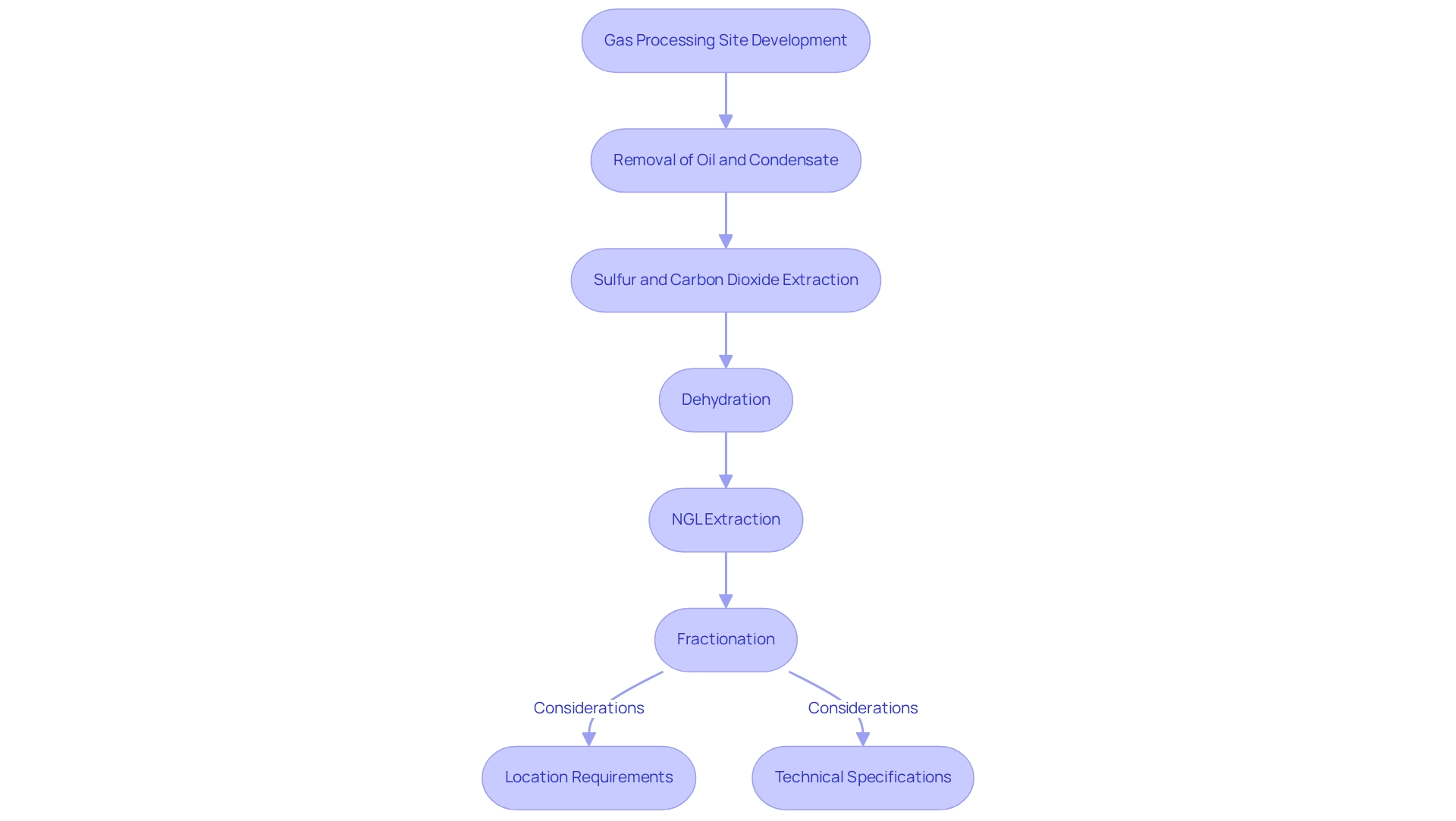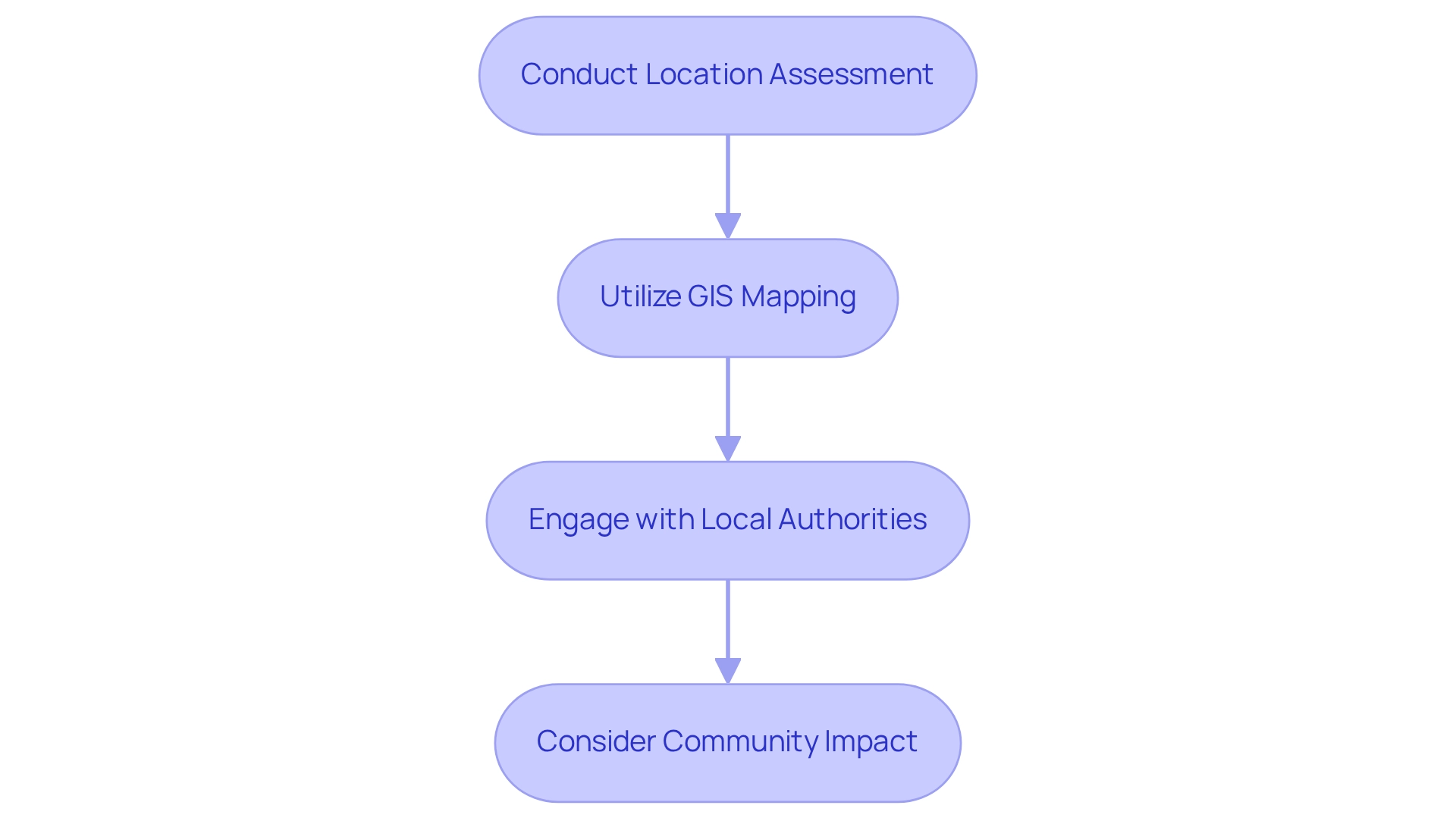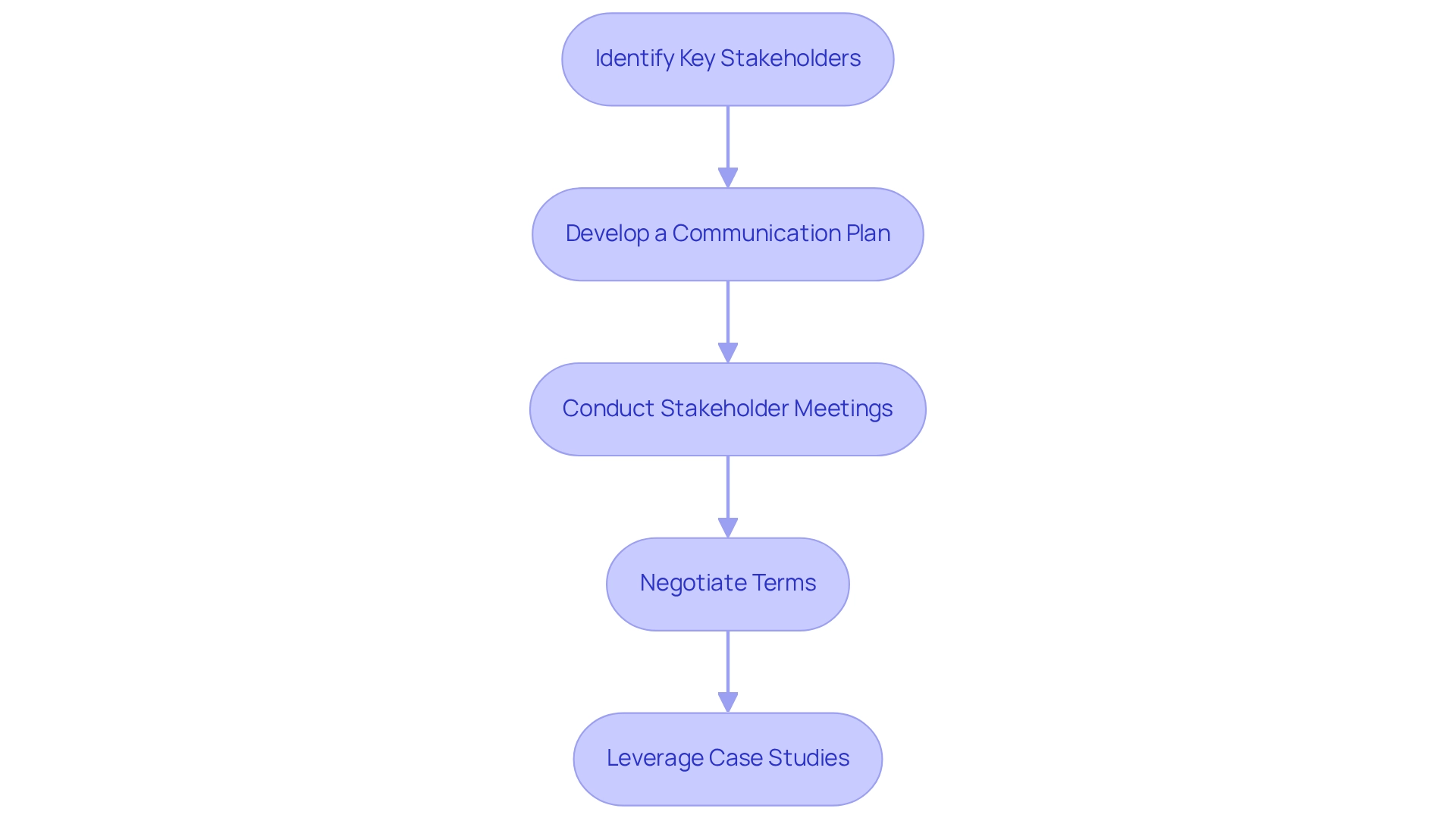Overview
The article delineates five crucial steps for effective gas processing site development. It emphasizes the significance of:
- Grasping development fundamentals
- Pinpointing appropriate land
- Navigating legal requirements
- Engaging stakeholders
- Harnessing technology
Each step is underpinned by practical strategies and case studies, underscoring the necessity of meticulous planning, community engagement, and innovative tools to boost operational efficiency and ensure compliance throughout the development process.
Introduction
In the intricate realm of gas processing site development, grasping the multifaceted stages—from impurity removal to effective land acquisition—is crucial. As the energy sector undergoes transformation, mastering these fundamentals not only boosts operational efficiency but also ensures adherence to stringent regulatory frameworks.
How can organizations leverage advanced technologies like GIS and AI while engaging stakeholders meaningfully? The path to successful project execution is paved with strategic insights and meticulous planning.
This article explores the essential components of gas processing site development, offering a comprehensive guide for industry professionals eager to navigate this complex landscape and achieve sustainable outcomes.
Understand Gas Processing Site Development Fundamentals
The development of gas treatment facilities encompasses several critical phases, including impurity removal, dehydration, and the extraction of natural gas liquids (NGLs). A comprehensive understanding of these stages is essential for effective gas processing site development planning. Familiarize yourself with the following key concepts:
- Stages of Gas Processing: The five primary stages include the removal of oil and condensate, sulfur and carbon dioxide extraction, dehydration, NGL extraction, and fractionation. Each stage is vital in ensuring that the natural gas is clean and suitable for use, as specialists emphasize the importance of purity in gas refinement. As noted by James G. Speight, Ph.D., D.Sc., "Thus gas treatment is instrumental in ensuring that the natural gas intended for use is as clean and pure as possible, making it the clean burning and an environmentally sound energy choice."
- Location Requirements: Recognizing the physical and environmental needs for gas processing site development is crucial. This encompasses factors such as proximity to pipelines and access to essential utilities, which can significantly influence operational efficiency.
- Technical Specifications: It is vital to understand the necessary technical specifications for equipment and infrastructure, as these influence gas processing site development and design. For instance, electrostatic precipitators can achieve efficiencies exceeding 99% under optimal conditions, highlighting the importance of selecting the right technology to ensure purity in gas treatment.
- Case Studies: Valuable insights can be gleaned from case studies like "Chemical Conversion Processes for Emission Control," which illustrate successful outcomes related to emission control in gas processing. These methods effectively reduce harmful gases, contributing to cleaner emissions and compliance with environmental standards.
- Recent Developments: Furthermore, the butane splitter plays a significant role in separating iso-butane from n-butane, generating streams suitable as petrochemical feedstocks, which is crucial in the extraction processes.
By mastering these fundamentals, you will be well-equipped to navigate the complexities of gas processing site development, ultimately leading to more successful project outcomes.

Identify Suitable Land for Development
Recognizing appropriate land for gas processing site development is a critical endeavor that necessitates a systematic approach, comprising several essential steps:
- Conduct a Location Assessment: Initiate the process by evaluating potential sites through comprehensive geological surveys and environmental impact assessments. It is vital to consider the proximity to existing infrastructure, such as pipelines and roads, as this significantly enhances operational efficiency. Research indicates that optimal locations for gas processing site development are often situated within 40.6 km of city centers, facilitating better access to resources and markets, which is essential for the effective operation of gas treatment facilities.
- Utilize GIS Mapping: Harness the power of Geographic Information Systems (GIS) to analyze land use patterns, zoning regulations, and environmental constraints. Recent advancements in GIS technology have markedly improved the precision of land selection processes, enabling more informed decision-making in gas processing site development. Insights from case studies, such as renewable installations in Iraq, illustrate how GIS can convert geospatial data into actionable insights, thereby enhancing the feasibility of energy projects.
- Engage with Local Authorities: Consulting with local government and planning agencies is crucial for navigating land use regulations effectively. A thorough understanding of the regulatory landscape aids in obtaining necessary permits and ensuring compliance with local laws. A collaborative approach in renewable energy planning, as highlighted in recent research, can streamline interactions with authorities and stakeholders.
- Consider Community Impact: Assessing the potential effects of the location on local communities is imperative, encompassing both disruptions and benefits. Engaging with community stakeholders fosters positive relationships and mitigates resistance, which is vital for the long-term success of the gas processing site development project. By methodically evaluating these elements, you can identify the most suitable land for your gas processing site development operations, ensuring alignment with both operational requirements and community expectations.

Navigate Legal and Regulatory Requirements
Successfully navigating the legal and regulatory landscape for gas processing site development involves several critical steps:
- Research Relevant Laws: Begin by thoroughly understanding federal, state, and local regulations governing gas handling. A comprehensive review of environmental laws and land use regulations that may impact your project is essential. Harbinger Land's advanced title research solutions ensure accurate ownership information, which is crucial for compliance.
- Obtain Necessary Permits: Identify all required permits, including environmental impact assessments, construction permits, and operational licenses. Timely acquisition of these permits is vital; statistics reveal that permit acquisition timelines can vary significantly, with some projects facing delays of up to 12 months if not managed effectively. Harbinger Land's expertise in site and right-of-way acquisitions simplifies this procedure, utilizing GIS modeling to identify potential issues early on.
- Engage Legal Counsel: Collaborate with legal experts specializing in energy and infrastructure. Their knowledge is essential for ensuring adherence to evolving regulations, particularly given recent modifications in environmental laws affecting gas handling, such as stricter emissions standards and improved review procedures. Harbinger Land works closely with legal experts to ensure that all compliance aspects are addressed, facilitating a smoother project development experience. A legal expert noted, "Navigating the complexities of energy regulations requires not just knowledge of the law but also an understanding of the broader implications for project development."
- Document Everything: Maintain meticulous records of all communications, permits, and compliance efforts. This documentation is critical for facilitating audits and inspections, serving as a safeguard against potential legal challenges. Harbinger Land offers efficient document imaging solutions that digitize property data, enabling title agents to complete title research and leasing in a cost-effective manner. For instance, a recent case study highlighted how a company successfully navigated the permit acquisition process by maintaining detailed documentation, ultimately accelerating their project timeline.
By proactively addressing these legal and regulatory obligations and leveraging Harbinger Land's expertise in mineral leasing and acquisitions, you can significantly reduce risks and streamline the gas processing site development phase, which will lead to more successful project outcomes.
Engage Stakeholders and Negotiate Effectively
Involving stakeholders and negotiating effectively during gas processing site development is essential for project success. To navigate the complexities of this process, consider the following steps:
- Identify Key Stakeholders: Recognize the primary stakeholders involved, including local communities, government agencies, and environmental organizations. Understanding their interests and concerns is vital for effective engagement.
- Develop a Communication Plan: Establish a comprehensive communication strategy that outlines how you will keep stakeholders informed. This should include regular updates, opportunities for feedback, and channels for addressing inquiries.
- Conduct Stakeholder Meetings: Schedule meetings to present project plans, address stakeholder concerns, and solicit input. These interactions not only build trust but also provide valuable insights that can enhance project outcomes.
- Negotiate Terms: Employ effective negotiation techniques to achieve agreements that balance project objectives with stakeholder interests. As Paul-Emeka George states, "strategic commercial negotiations are instrumental in advancing sustainable development in the energy sector." Focus on creating win-win scenarios that foster collaboration and minimize resistance.
- Leverage Case Studies: Analyze recent case studies that highlight successful stakeholder engagement and negotiation strategies in energy infrastructure. For instance, a notable case study on business process analysis in the energy sector demonstrates how systematic redesign of processes can streamline operations and enhance stakeholder satisfaction, illustrating the critical role of effective engagement and negotiation.
By prioritizing stakeholder involvement and utilizing strategic negotiation methods, you can foster positive relationships that enable smoother project execution and support the long-term sustainability of gas processing site development.

Leverage Technology for Efficient Land Acquisition
Leveraging advanced technology is essential to optimize land acquisition for gas processing site development. Consider the following key strategies:
- Implement AI-Powered Tools: Utilize AI-driven software for title research and land assessments. These tools significantly expedite the acquisition procedure while enhancing accuracy, allowing for more informed decision-making. As noted by Ghahfarokhi et al., the application of multi-layer perceptron neural networks can further refine these methods, providing deeper insights into land data.
- Adopt GIS Technology: GIS mapping tools are invaluable for visualizing land parcels and analyzing spatial data. They facilitate the identification of optimal acquisition strategies by offering insights into land use patterns and environmental considerations. The evolution of surveying from basic tools to sophisticated GIS technologies exemplifies the transformative impact of digital tools in resource management, making them indispensable for competitive organizations in the energy sector.
- Employ Digital Platforms: Digital platforms simplify the management of landowner interactions, track agreements, and assist in documentation tasks. This integration not only enhances communication but also ensures that all stakeholders remain aligned throughout the acquisition process. Additionally, Harbinger Land's document imaging solutions improve the efficiency of title research and leasing, enabling swift access to essential property data through imaging agents deployed to courthouses or via records requests. These solutions are designed to be cost-effective, significantly reducing the time and resources required for document acquisition.
- Stay Informed on Innovations: Keeping abreast of the latest advancements in land acquisition technologies is crucial. Emerging tools, such as adaptive network-based fuzzy inference systems, can analyze factors like water saturation in wells, thereby improving planning and adherence to environmental regulations. A thorough analysis of potential environmental impacts, as highlighted in the case study on Environmental Impact Analysis in Site Assessments, is vital during gas processing site development, ensuring compliance with regulations and promoting sustainable development.
By embedding these technologies into your land acquisition strategy, including efficient document imaging solutions from Harbinger Land, you can significantly enhance efficiency, reduce costs, and achieve superior project outcomes. The integration of digital tools for resource management will become increasingly significant for competitive organizations, reinforcing the necessity for innovation in land acquisition practices.
Conclusion
Navigating the complexities of gas processing site development is crucial for achieving sustainable outcomes in the energy sector. A comprehensive understanding of key stages—from impurity removal to natural gas liquids extraction—facilitates effective planning and operational efficiency.
Identifying suitable land requires a systematic approach, encompassing site assessments, GIS mapping, and local authority engagement. By considering community impacts and fostering positive stakeholder relationships, organizations can align their projects with operational needs and local expectations.
Addressing the legal and regulatory landscape is essential. Comprehensive research, timely permit acquisition, and meticulous documentation are necessary for compliance and successful project execution. Collaborating with legal experts can streamline this process, ensuring adherence to evolving regulations.
Effective stakeholder engagement and negotiation minimize resistance and promote collaboration. By recognizing key stakeholders and maintaining open communication, organizations can build trust and gain insights that enhance project outcomes.
Leveraging advanced technologies, such as AI and GIS, optimizes land acquisition processes, increasing efficiency and reducing costs. Staying informed about innovations in land management is vital for maintaining a competitive edge.
In summary, mastering gas processing site development not only leads to successful projects but also fosters sustainability. By embracing strategic insights, engaging stakeholders, and leveraging technological advancements, organizations can pave the way for a more efficient and environmentally responsible future in the energy sector.
Frequently Asked Questions
What are the critical phases involved in the development of gas treatment facilities?
The critical phases include impurity removal, dehydration, and the extraction of natural gas liquids (NGLs).
What are the primary stages of gas processing?
The five primary stages are the removal of oil and condensate, sulfur and carbon dioxide extraction, dehydration, NGL extraction, and fractionation.
Why is purity important in gas refinement?
Purity is essential in gas refinement to ensure that the natural gas is clean and suitable for use, making it a clean-burning and environmentally sound energy choice.
What factors should be considered for location requirements in gas processing site development?
Factors include proximity to pipelines, access to essential utilities, and other physical and environmental needs that influence operational efficiency.
What technical specifications are important for gas processing site development?
Understanding the necessary technical specifications for equipment and infrastructure is crucial, as these influence the design and efficiency of gas processing. For instance, electrostatic precipitators can achieve efficiencies exceeding 99% under optimal conditions.
How can case studies contribute to understanding gas processing?
Case studies, such as 'Chemical Conversion Processes for Emission Control,' provide valuable insights into successful methods for emission control in gas processing, contributing to cleaner emissions and compliance with environmental standards.
What recent developments are significant in gas processing?
The butane splitter plays a significant role in separating iso-butane from n-butane, generating streams suitable as petrochemical feedstocks, which is crucial in the extraction processes.
What steps are involved in recognizing appropriate land for gas processing site development?
The steps include conducting a location assessment, utilizing GIS mapping, engaging with local authorities, and considering community impact.
How does GIS mapping aid in gas processing site development?
GIS mapping helps analyze land use patterns, zoning regulations, and environmental constraints, improving the precision of land selection processes for gas processing sites.
Why is it important to engage with local authorities during site development?
Engaging with local authorities helps navigate land use regulations, obtain necessary permits, and ensure compliance with local laws, which is crucial for the project's success.
What is the significance of assessing community impact in gas processing site development?
Assessing community impact is imperative to understand potential disruptions and benefits, fostering positive relationships with stakeholders and mitigating resistance for long-term success.
List of Sources
- Understand Gas Processing Site Development Fundamentals
- Gas Processing - an overview | ScienceDirect Topics (https://sciencedirect.com/topics/engineering/gas-processing)
- Development Process for Oil and Gas Production (https://oilandgasbmps.org/resources/development.php)
- Identify Suitable Land for Development
- Multi-criteria GIS-based approach for optimal site selection of solar and wind energy (https://sciencedirect.com/science/article/pii/S2666519025000585)
- Jack Dangermond Quotes - BrainyQuote (https://brainyquote.com/authors/jack-dangermond-quotes)
- Top 33 Quotes About Gis: Famous Quotes & Sayings About Gis (https://quotestats.com/topic/quotes-about-gis)
- Navigate Legal and Regulatory Requirements
- Oil & Gas Laws and Regulations Report 2025 USA (https://iclg.com/practice-areas/oil-and-gas-laws-and-regulations/usa)
- babachanian.com (https://babachanian.com/resources/legal-quotes-edited-by-babachanian)
- Engage Stakeholders and Negotiate Effectively
- (PDF) Stakeholder engagement and influence: Strategies for successful energy projects (https://researchgate.net/publication/382514218_Stakeholder_engagement_and_influence_Strategies_for_successful_energy_projects)
- Leverage Technology for Efficient Land Acquisition
- Application of machine learning and artificial intelligence in oil and gas industry (https://sciencedirect.com/science/article/pii/S2096249521000429)
- The Role of GIS Mapping in Land Acquisition: A Comprehensive Guide (https://blog.harbingerland.com/the-role-of-gis-mapping-in-land-acquisition-a-comprehensive-guide)
- Best Practices for Well Pad Site Assessments: Ensuring Compliance and Efficiency in Land Acquisition (https://blog.harbingerland.com/best-practices-for-well-pad-site-assessments-ensuring-compliance-and-efficiency-in-land-acquisition)




